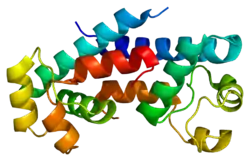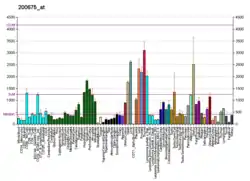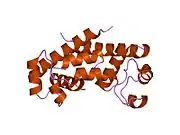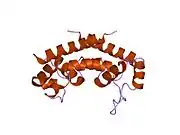CD81
CD81 molecule, also known as CD81 (Cluster of Differentiation 81), is a protein which in humans is encoded by the CD81 gene.[5][6] It is also known as 26 kDa cell surface protein, TAPA-1 (Target of the Antiproliferative Antibody 1), and Tetraspanin-28 (Tspan-28).
Gene
The gene is located on the plus strand of the short arm of chromosome 11 (11p15.5). It is 20,103 bases in length and encodes a protein of 236 amino acids (predicted molecular weight 25.809 kDa).[6]
The protein does not appear to be post translationally modified and has four transmembrane domains. Both the N-terminus and C-terminus lie on the intracellular side of the membrane.
The gene is expressed in hemopoietic, endothelial, and epithelial cells. It is absent from erythrocytes, platelets, and neutrophils.
Function
The protein encoded by this gene is a member of the transmembrane 4 superfamily, also known as the tetraspanin family. Most of these members are cell-surface proteins that are characterized by the presence of four hydrophobic domains. The proteins mediate signal transduction events that play a role in the regulation of cell development, activation, growth and motility. This encoded protein is a cell surface glycoprotein that is known to complex with integrins. This protein appears to promote muscle cell fusion and support myotube maintenance. Also it may be involved in signal transduction. This gene is localized in the tumor-suppressor gene region and thus it is a candidate gene for malignancies.[5]
The tetraspanin family includes CD9, CD37, CD53, CD63, CD81 (this protein), CD82 and CD151.
CD81 interacts directly with immunoglobulin superfamily member 8 (IGSF8,[7] CD316) and CD36. It forms a signal transduction complex with CD19, CD21 and Leu-13 (CD225) on the surface of the B cell.[8] On T cells CD81 associates with CD4 and CD8 and provides a costimulatory signal with CD3.[8]
Clinical significance
This protein plays a critical role in Hepatitis C attachment and/or cell entry by interacting with virus' E1/E2 glycoproteins heterodimer.[9] The large extracellular loop of CD81 binds the hepatitis E2 glycoprotein dimer. HCV-E2 and CD81 binding Kd is 1.8 nM. HCV-E2 engaged CD81 is only 30% internalized after 12hr, suggesting CD81 may be primarily an attachment receptor for HCV.[10]
It also appears to play a role in liver invasion by Plasmodium species.[11] CD81 is required for Plasmodium vivax sporozoite entry into human hepatocytes and for Plasmodium yoelii sporozoite entry into murine hepatocytes.[12]
HIV gag proteins use tetraspanin enriched microdomains (containing minimally CD81, CD82, CD63) as a platform for virion assembly and release. Purified HIV produced by MOLT\HIV cells contains CD81. Anti-CD81 antibodies downregulate HIV production 3 fold, however the CD81 protein free virus is more infectious.[13] Engagement of CD81 lowers the signaling threshold required to trigger T-Cell\CD3 mediated proviral DNA in CD4+ T cells.[14]
CD81 appears to play a role in the pathogenesis of influenza.[15]
Interactions
CD81 has been shown to interact with TSPAN4,[16] CD19,[17][18][19] CD9,[19][20] PTGFRN,[21][22] CD117[23] and CD29.[24][25]
Ligands
Benzyl salicylate[26] and terfenadine[27] have been shown to bind to CD81.
See also
References
- GRCh38: Ensembl release 89: ENSG00000110651 - Ensembl, May 2017
- GRCm38: Ensembl release 89: ENSMUSG00000037706 - Ensembl, May 2017
- "Human PubMed Reference:". National Center for Biotechnology Information, U.S. National Library of Medicine.
- "Mouse PubMed Reference:". National Center for Biotechnology Information, U.S. National Library of Medicine.
- "Entrez Gene: CD81 CD81 molecule".
- Andria ML, Hsieh CL, Oren R, Francke U, Levy S (August 1991). "Genomic organization and chromosomal localization of the TAPA-1 gene". Journal of Immunology. 147 (3): 1030–6. PMID 1650385.
- Clark K.L.; Zeng Z.; Langford A.L.; Bowen S.M.; Todd S.C. (November 2001). "PGRL is a major CD81-associated protein on lymphocytes and distinguishes a new family of cell surface proteins". Journal of Immunology. 167 (9): 5115–5121. doi:10.4049/jimmunol.167.9.5115. PMID 11673522.
- Levy S, Todd SC, Maecker HT (1998). "CD81 (TAPA-1): a molecule involved in signal transduction and cell adhesion in the immune system". Annu Rev Immunol. 16: 89–109. doi:10.1146/annurev.immunol.16.1.89. PMID 9597125.
- Bartosch B, Vitelli A, Granier C, Goujon C, Dubuisson J, Pascale S, Scarselli E, Cortese R, Nicosia A, Cosset FL (October 2003). "Cell entry of hepatitis C virus requires a set of co-receptors that include the CD81 tetraspanin and the SR-B1 scavenger receptor". The Journal of Biological Chemistry. 278 (43): 41624–30. doi:10.1074/jbc.M305289200. PMID 12913001.
- Petracca R, Falugi F, Galli G, Norais N, Rosa D, Campagnoli S, Burgio V, Di Stasio E, Giardina B, Houghton M, Abrignani S, Grandi G (May 2000). "Structure-function analysis of hepatitis C virus envelope-CD81 binding". J. Virol. 74 (10): 4824–30. doi:10.1128/jvi.74.10.4824-4830.2000. PMC 112005. PMID 10775621.
- Yalaoui S, Zougbédé S, Charrin S, Silvie O, Arduise C, Farhati K, Boucheix C, Mazier D, Rubinstein E, Froissard P (February 2008). "Hepatocyte Permissiveness to Plasmodium Infection Is Conveyed by a Short and Structurally Conserved Region of the CD81 Large Extracellular Domain". PLOS Pathogens. 4 (2): e1000010. doi:10.1371/journal.ppat.1000010. PMC 2279262. PMID 18389082.
- Silvie O, Rubinstein E, Franetich JF, Prenant M, Belnoue E, Rénia L, Hannoun L, Eling W, Levy S, Boucheix C, Mazier D (January 2003). "Hepatocyte CD81 is required for Plasmodium falciparum and Plasmodium yoelii sporozoite infectivity". Nat. Med. 9 (1): 93–6. doi:10.1038/nm808. PMID 12483205. S2CID 6290736.
- Grigorov B, Attuil-Audenis V, Perugi F, Nedelec M, Watson S, Pique C, Darlix JL, Conjeaud H, Muriaux D (2009). "A role for CD81 on the late steps of HIV-1 replication in a chronically infected T cell line". Retrovirology. 6: 28. doi:10.1186/1742-4690-6-28. PMC 2657109. PMID 19284574.
- Tardif MR, Tremblay MJ (April 2005). "Tetraspanin CD81 provides a costimulatory signal resulting in increased human immunodeficiency virus type 1 gene expression in primary CD4+ T lymphocytes through NF-kappaB, NFAT, and AP-1 transduction pathways". J. Virol. 79 (7): 4316–28. doi:10.1128/JVI.79.7.4316-4328.2005. PMC 1061526. PMID 15767432.
- He J, Sun E, Bujny MV, Kim D, Davidson MW, Zhuang X (October 2013). "Dual Function of CD81 in Influenza Virus Uncoating and Budding". PLOS Pathog. 9 (10): e1003701. doi:10.1371/journal.ppat.1003701. PMC 3795033. PMID 24130495.
- Tachibana I, Bodorova J, Berditchevski F, Zutter MM, Hemler ME (Nov 1997). "NAG-2, a novel transmembrane-4 superfamily (TM4SF) protein that complexes with integrins and other TM4SF proteins". J. Biol. Chem. 272 (46): 29181–9. doi:10.1074/jbc.272.46.29181. PMID 9360996.
- Bradbury LE, Kansas GS, Levy S, Evans RL, Tedder TF (Nov 1992). "The CD19/CD21 signal transducing complex of human B lymphocytes includes the target of antiproliferative antibody-1 and Leu-13 molecules". J. Immunol. 149 (9): 2841–50. PMID 1383329.
- Imai T, Kakizaki M, Nishimura M, Yoshie O (Aug 1995). "Molecular analyses of the association of CD4 with two members of the transmembrane 4 superfamily, CD81 and CD82". J. Immunol. 155 (3): 1229–39. PMID 7636191.
- Horváth G, Serru V, Clay D, Billard M, Boucheix C, Rubinstein E (Nov 1998). "CD19 is linked to the integrin-associated tetraspans CD9, CD81, and CD82". J. Biol. Chem. 273 (46): 30537–43. doi:10.1074/jbc.273.46.30537. PMID 9804823.
- Radford KJ, Thorne RF, Hersey P (May 1996). "CD63 associates with transmembrane 4 superfamily members, CD9 and CD81, and with beta 1 integrins in human melanoma". Biochem. Biophys. Res. Commun. 222 (1): 13–8. doi:10.1006/bbrc.1996.0690. PMID 8630057.
- Charrin S, Le Naour F, Oualid M, Billard M, Faure G, Hanash SM, Boucheix C, Rubinstein E (Apr 2001). "The major CD9 and CD81 molecular partner. Identification and characterization of the complexes". J. Biol. Chem. 276 (17): 14329–37. doi:10.1074/jbc.M011297200. PMID 11278880.
- Stipp CS, Orlicky D, Hemler ME (Feb 2001). "FPRP, a major, highly stoichiometric, highly specific CD81- and CD9-associated protein". J. Biol. Chem. 276 (7): 4853–62. doi:10.1074/jbc.M009859200. PMID 11087758.
- Anzai N; Lee Younghee; Youn Byung-S; Fukuda Seiji; Kim Young-June; Mantel Charlie; Akashi Makoto; Broxmeyer Hal E (Jun 2002). "C-kit associated with the transmembrane 4 superfamily proteins constitutes a functionally distinct subunit in human hematopoietic progenitors". Blood. 99 (12): 4413–21. doi:10.1182/blood.V99.12.4413. PMID 12036870.
- Serru V, Le Naour F, Billard M, Azorsa DO, Lanza F, Boucheix C, Rubinstein E (May 1999). "Selective tetraspan-integrin complexes (CD81/alpha4beta1, CD151/alpha3beta1, CD151/alpha6beta1) under conditions disrupting tetraspan interactions". Biochem. J. 340 (Pt 1): 103–11. doi:10.1042/0264-6021:3400103. PMC 1220227. PMID 10229664.
- Mazzocca A; Carloni Vinicio; Sciammetta Silvia; Cordella Claudia; Pantaleo Pietro; Caldini Anna; Gentilini Paolo; Pinzani Massimo (Sep 2002). "Expression of transmembrane 4 superfamily (TM4SF) proteins and their role in hepatic stellate cell motility and wound healing migration". J. Hepatol. 37 (3): 322–30. doi:10.1016/S0168-8278(02)00175-7. PMID 12175627.
- Rajesh S, Sridhar P, Tews BA, Fénéant L, Cocquerel L, Ward DG, Berditchevski F, Overduin M (June 2012). "Structural basis of ligand interactions of the large extracellular domain of tetraspanin CD81". J Virol. 86 (18): 9606–16. doi:10.1128/JVI.00559-12. PMC 3446547. PMID 22740401.
- Holzer M, Ziegler S, Albrecht B, Kronenberger B, Kaul A, Bartenschlager R, Kattner L, Klein CD, Hartmann RW (2008). "Identification of terfenadine as an inhibitor of human CD81-receptor HCV-E2 interaction: synthesis and structure optimization". Molecules. 13 (5): 1081–110. doi:10.3390/molecules13051081. PMC 6245452. PMID 18560330.
Further reading
- Berditchevski F (2002). "Complexes of tetraspanins with integrins: more than meets the eye". J. Cell Sci. 114 (Pt 23): 4143–51. doi:10.1242/jcs.114.23.4143. PMID 11739647.
- Ye J (2007). "Reliance of Host Cholesterol Metabolic Pathways for the Life Cycle of Hepatitis C Virus". PLOS Pathog. 3 (8): e108. doi:10.1371/journal.ppat.0030108. PMC 1959368. PMID 17784784.
- Bradbury LE, Kansas GS, Levy S, et al. (1992). "The CD19/CD21 signal transducing complex of human B lymphocytes includes the target of antiproliferative antibody-1 and Leu-13 molecules". J. Immunol. 149 (9): 2841–50. PMID 1383329.
- Andria ML, Hsieh CL, Oren R, et al. (1991). "Genomic organization and chromosomal localization of the TAPA-1 gene". J. Immunol. 147 (3): 1030–6. PMID 1650385.
- Oren R, Takahashi S, Doss C, et al. (1990). "TAPA-1, the target of an antiproliferative antibody, defines a new family of transmembrane proteins". Mol. Cell. Biol. 10 (8): 4007–15. doi:10.1128/MCB.10.8.4007. PMC 360911. PMID 1695320.
- Levy S, Nguyen VQ, Andria ML, Takahashi S (1991). "Structure and membrane topology of TAPA-1". J. Biol. Chem. 266 (22): 14597–602. doi:10.1016/S0021-9258(18)98728-4. PMID 1860863.
- Takahashi S, Doss C, Levy S, Levy R (1990). "TAPA-1, the target of an antiproliferative antibody, is associated on the cell surface with the Leu-13 antigen". J. Immunol. 145 (7): 2207–13. PMID 2398277.
- Matsumoto AK, Martin DR, Carter RH, et al. (1993). "Functional dissection of the CD21/CD19/TAPA-1/Leu-13 complex of B lymphocytes". J. Exp. Med. 178 (4): 1407–17. doi:10.1084/jem.178.4.1407. PMC 2191213. PMID 7690834.
- Nagira M, Imai T, Ishikawa I, et al. (1994). "Mouse homologue of C33 antigen (CD82), a member of the transmembrane 4 superfamily: complementary DNA, genomic structure, and expression". Cell. Immunol. 157 (1): 144–57. doi:10.1006/cimm.1994.1212. PMID 8039242.
- Virtaneva KI, Emi N, Marken JS, et al. (1994). "Chromosomal localization of three human genes coding for A15, L6, and S5.7 (TAPA1): all members of the transmembrane 4 superfamily of proteins". Immunogenetics. 39 (5): 329–34. doi:10.1007/BF00189229. PMID 8168850. S2CID 22971645.
- Radford KJ, Thorne RF, Hersey P (1996). "CD63 associates with transmembrane 4 superfamily members, CD9 and CD81, and with beta 1 integrins in human melanoma". Biochem. Biophys. Res. Commun. 222 (1): 13–8. doi:10.1006/bbrc.1996.0690. PMID 8630057.
- Szöllósi J, Horejsí V, Bene L, et al. (1996). "Supramolecular complexes of MHC class I, MHC class II, CD20, and tetraspan molecules (CD53, CD81, and CD82) at the surface of a B cell line JY". J. Immunol. 157 (7): 2939–46. PMID 8816400.
- Berditchevski F, Tolias KF, Wong K, et al. (1997). "A novel link between integrins, transmembrane-4 superfamily proteins (CD63 and CD81), and phosphatidylinositol 4-kinase". J. Biol. Chem. 272 (5): 2595–8. doi:10.1074/jbc.272.5.2595. PMID 9006891.
- Berditchevski F, Chang S, Bodorova J, Hemler ME (1997). "Generation of monoclonal antibodies to integrin-associated proteins. Evidence that alpha3beta1 complexes with EMMPRIN/basigin/OX47/M6". J. Biol. Chem. 272 (46): 29174–80. doi:10.1074/jbc.272.46.29174. PMID 9360995.
- Tachibana I, Bodorova J, Berditchevski F, et al. (1997). "NAG-2, a novel transmembrane-4 superfamily (TM4SF) protein that complexes with integrins and other TM4SF proteins". J. Biol. Chem. 272 (46): 29181–9. doi:10.1074/jbc.272.46.29181. PMID 9360996.
- Hu RJ, Lee MP, Connors TD, et al. (1998). "A 2.5-Mb transcript map of a tumor-suppressing subchromosomal transferable fragment from 11p15.5, and isolation and sequence analysis of three novel genes". Genomics. 46 (1): 9–17. doi:10.1006/geno.1997.4981. PMID 9403053.
- Pileri P, Uematsu Y, Campagnoli S, et al. (1998). "Binding of hepatitis C virus to CD81". Science. 282 (5390): 938–41. Bibcode:1998Sci...282..938P. doi:10.1126/science.282.5390.938. PMID 9794763.
- Serru V, Le Naour F, Billard M, et al. (1999). "Selective tetraspan-integrin complexes (CD81/alpha4beta1, CD151/alpha3beta1, CD151/alpha6beta1) under conditions disrupting tetraspan interactions". Biochem. J. 340 (Pt 1): 103–11. doi:10.1042/0264-6021:3400103. PMC 1220227. PMID 10229664.
- Tachibana I, Hemler ME (1999). "Role of Transmembrane 4 Superfamily (Tm4sf) Proteins Cd9 and Cd81 in Muscle Cell Fusion and Myotube Maintenance". J. Cell Biol. 146 (4): 893–904. doi:10.1083/jcb.146.4.893. PMC 2156130. PMID 10459022.
- Higginbottom A, Quinn ER, Kuo CC, et al. (2000). "Identification of Amino Acid Residues in CD81 Critical for Interaction with Hepatitis C Virus Envelope Glycoprotein E2". J. Virol. 74 (8): 3642–9. doi:10.1128/JVI.74.8.3642-3649.2000. PMC 111874. PMID 10729140.
External links
- CD81+protein,+human at the U.S. National Library of Medicine Medical Subject Headings (MeSH)
- Human CD81 genome location and CD81 gene details page in the UCSC Genome Browser.
This article incorporates text from the United States National Library of Medicine, which is in the public domain.







